Philadelphia Trolley Routes: By The Numbers
Abandonments and bus conversions of Philadelphia streetcar routes did not begin
in earnest until after the National City Lines (General Motors) management took
control of Philadelphia Transportation Company in 1955. (See the 1953
PTC Trolley Routes list.)
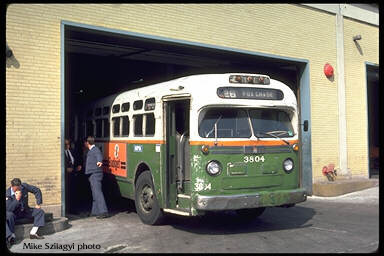 By 1958, almost one thousand trolleys and thirty-five
trolley routes had been scrapped, replaced by a fleet of as many new General
Motors diesel buses (National City Lines was organized by General Motors, Firestone
Tire, Standard Oil and Phillips Petroleum). The remaining fleet of about 500
PCC trolleys served the fourteen surviving routes, including the five lines
that utilized the city's new extension to the Subway-Surface tunnel.
By 1958, almost one thousand trolleys and thirty-five
trolley routes had been scrapped, replaced by a fleet of as many new General
Motors diesel buses (National City Lines was organized by General Motors, Firestone
Tire, Standard Oil and Phillips Petroleum). The remaining fleet of about 500
PCC trolleys served the fourteen surviving routes, including the five lines
that utilized the city's new extension to the Subway-Surface tunnel.
For ten years after the 1950s bustitutions, the heavily pruned trolley
network survived without further vandalism. However, within a year of new public
transit authority SEPTA's acquisition of the PTC, trolley Route 47 was abandoned
and replaced with diesel buses. Another ten years would pass before the next
SEPTA bus substitution, this time the Route 60 on Allegheny Avenue. Both had
operated from Luzerne Depot in the Hunting Park section of the city.
(In 1971, the Route 62 shuttle trolley in Darby and Yeadon Boroughs was replaced
by rush hour-only Route 13 trolley service.)
In 1981, a fleet of 112 new SEPTA-designed,
Kawasaki-built LRVs arrived for service on the five
routes that operate through the Subway-Surface tunnel and the streets of Southwest Philadelphia. At
that time, the new Elmwood Depot was completed and a new trolley maintenance shop replaced
the Civil War-vintage Woodland Carbarn. The future of the Southwest Philadelphia Subway-Surface
trolley network seemed secure.
But the North Philadelphia streetcar system saw no such investment in infrastructure,
aside from sporadic track replacements. On the other hand, SEPTA did rebuild
one hundred and twelve 1947-48 PCCs for the North Philadelphia streetcar lines.
Output of "GOH" PCCs was as follows:
SEPTA General OverHaul PCC rebuilding project
---------------------------------------------
Table showing quantity of cars rebuilt, by year
1979 1980 1981 1982 1983 1984 1985 1986 1987 1988 total
---- ---- ---- ---- ---- ---- ---- ---- ---- ---- -----
1* 6 16 23 19 14 14 14 5 1 112
*PCC 2715 was the pilot GOH car, and was not included in the total count.
PCCs completed through 1984 were rebuilt at Courtland Shops.
PCCs completed starting in 1985 were rebuilt at Woodland Shop.
Despite this large fleet of renewed PCCs, SEPTA management
seemed to give up on the North Philadelphia trolley network. The Route 50 saw
its last streetcar in 1980. By 1986, the Routes 6 and 53 were dropped. In 1992,
only the routes 15, 23, and 56 remained, and in August of that year, the city
administration dropped its opposition to SEPTA's plan to "temporarily" operate
these last three routes with diesel buses. As part of the deal with the City,
SEPTA promised to purchase new light rail vehicles for those lines, with a target
date of 1997. Instead, four hundred diesel buses were purchased, and Luzerne Depot
slated for demolition. The fleet of recently overhauled PCCs was dispersed across
the country. Some were scrapped by SEPTA, others purchased by museums, and some
bought by cities that still see some value in the cars, notably, San
Francisco's Municipal Railway.
Route 51 was a short-lived effort to operate a tourist-oriented streetcar line from Center City to Philadelphia Zoo. Three refurbished PCC cars ran on dormant sections of Route 23 and Route 15 tracks. Poor publicity resulted in few riders. Route 51 operated sporadically during 1995 and 1996.
In September 1997, faced with the City's threat to withhold its share of funding
for SEPTA, the transit authority made good on its promise to restore trolleys
to Route 15 Girard Avenue. After bids for a small fleet of new low-floor LRVs
came in at around a staggering (at the time) $3 million per car, it was decided
that the mothballed fleet of postwar PCCs might be rebuilt instead. Near the
beginning of the Route 15 trolley restoration project, anti-trolley managers
were promoted within SEPTA, and tried to kill the trolley project. SEPTA management's
effort to scuttle the Girard Avenue project ultimately failed, but the anti-trolley
managers continued to sabotage the Route 15 project whenever possible. Instead
of 26 rebuilt trolleys, only 18 were ordered. Eighteen is not enough trolleys
for Route 15, so service is often provided by a mix of trolleys and diesel buses.
Even though it would have been relatively inexpensive to do so, the eighteen
rebuilt streamlined trolleys were deliberately not fitted with electronic signal
gear that would have enabled their use in the Center City trolley subway. Therefore
the rebuilt streamliners are restricted to Girard Avenue, and occasional special
charter service. Thus has the anti-trolley management within SEPTA succeeded
in marginalizing what any other city would see as a tremendous asset and source
of civic pride.
SEPTA specified a 15 year life expectancy for the Route 15 streetcars, which
were placed in service in 2005. Fifteen years later, in January 2020, SEPTA
sidelined the Route 15 trolleys, replacing clean electric streetcars with diesel
buses.
Legend:


 Trolley Lines abandoned by
SEPTA during the 1980's
Trolley Lines abandoned by
SEPTA during the 1980's


 Trolley Lines abandoned by SEPTA
-- supposedly "suspended" since 1992
Trolley Lines abandoned by SEPTA
-- supposedly "suspended" since 1992


 Subway-Surface
Trolley Lines and Route 15 Trolley -- IN SERVICE TODAY
Subway-Surface
Trolley Lines and Route 15 Trolley -- IN SERVICE TODAY

These colors coincide with the legend used
on the Philadelphia Trolley Map.


Route 6

Route 6 was
a remnant of the suburban line that once ran to Willow Grove. After
the June 1958 cut-back, Route 6 ran between Cheltenham Shopping Center
and Olney terminal, running along wide Ogontz Avenue. Despite objections
from the City, the SEPTA board voted to convert Route 6 to a diesel
bus line. The last day for streetcar service was January 11, 1986. That
SEPTA would convert this viable streetcar line to diesel buses indicated
how bleak the future was for the North Philadelphia trolley network.
ex-Birmingham, ex-Toronto Pullman PCC 2302 on Park Avenue at Olney
Avenue. June 1981 photo by Mike Szilagyi |
 |
|
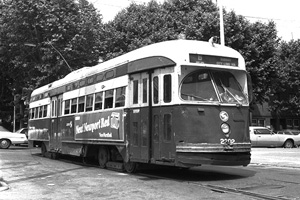
|

(Route 6 originally ran to Willow
Grove)

| A new streetcar
line connecting Philadelphia to the Willow Grove amusement park was
completed in 1907. The double-track line operated on private right-of-way,
with some in-street trackage through Glenside and Abington Township.
The suburban Montgomery County portion of the line was abandoned in
1958. This left only the street trackage on Ogontz Avenue in Philadelphia
(see above). This photo shows the last car, in the first light of Sunday
June 8, 1958, at the terminal at Willow Grove Park. 1948 PCC 2134,
Last Car to Willow Grove, on June 8, 1958 |
 |
|
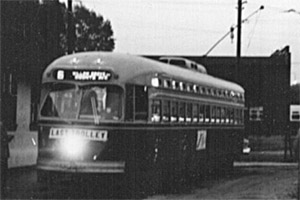
|

Route 10

Route 10 runs
from West Overbrook to University City, and then through the Subway-Surface
tunnel, looping at Juniper St. under city hall. A new depot, heavy
maintenance shop, and 112 new LRVs were furnished for the five Subway-Surface
lines in the early 1980's, insuring their survival.
1948 PCC 2095 southbound on 36th St. approaching the portal near
Market St. October 1979 photo by Mike Szilagyi |
 |
|
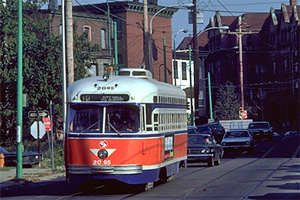
|

Route 11

Subway-Surface
Route 11 streetcars run beneath Center City, then on Woodland Avenue
to Darby Borough in Delaware County. Pre-war "air cars" such as 1940
PCC 2562 mixed with postwar PCCs until the Kawasaki LRVs replaced them.
Westbound PCC 2562 on Woodland Avenue near 72nd Street. June 1981
photo by Mike Szilagyi |
 |
|
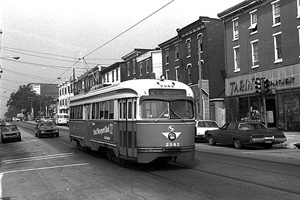
|

Route 13

Route 13, the
Chester Avenue line, was re-routed through the Subway-Surface tunnel
when the extension opened in 1956. PCC 2050, delivered to Philadelphia
in February 1941, leaves the subway portal for street running at 40th
Street. The "superblock" dormitories of the University of Pennsylvania
campus loom in the background.
May 1981 photo by Mike Szilagyi |
 |
|
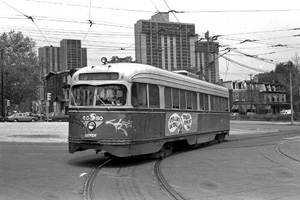
|

Route 15

Operating
out of West Philadelphia's Callowhill Depot, Route 15 runs from the
West Philadelphia neighborhood of Haddington, across North Philadelphia
on Girard Avenue, then on Richmond Street to Port Richmond. One of
three routes made "temporary bus" in September 1992, political pressure
in the late 1990s forced SEPTA to plan for restoration of trolley
service on one of the routes: 15. Trolley service was restored in
2005, only to be withdrawn (again) in January 2020.
Westbound PCC 2716 meets PCC 2710 on Girard Avenue at Philadelphia
Zoo. June 1979 photo by Mike Szilagyi |
 |
|
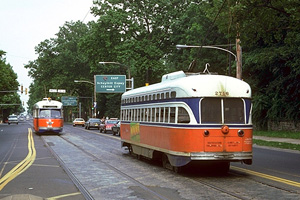
|

Route 23

Route 23, Philadelphia's
(and the world's) longest streetcar route, was one of three "suspended"
by the SEPTA board in 1992. Running from South Phila, through Center
City on 11th and 12th Streets, the 23 continues north on Germantown
Avenue through North Philly to Chestnut Hill. Despite millions invested
by the city and state governments to replace rails and overhead wires
in Mt Airy and Germantown, SEPTA managment has no interest in restoring
streetcar service.
1940 PCC 2501 with follower northbound on Germantown Avenue near
Erie Avenue. July 13, 1977 photo by Mike Szilagyi |
 |
|
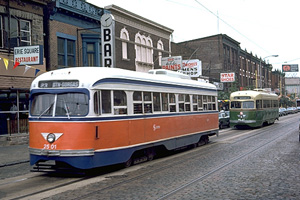
|

Route 34

Route 34, the
shortest of the West Phila Subway-Surface lines, runs from the Delaware
County line at Cobbs Creek, along Baltimore Avenue en route to Center
City. As the line approaches the subway portal at 40th Street, it passes
through the newly designated "Streetcar Suburb" historic district, west
of University City. Penn now offers a $15,000 grant to university employees
who purchase homes in this area.
1942 PCC 2658 heads toward Center City on Baltimore Avenue near
48th St., May, 1981 photo by Mike Szilagyi |
 |
|
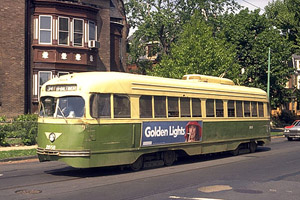
|

Route 36

Route 36 begins
at the Penrose Plaza shopping center, near Philadelphia Int' Airport,
and uses the reserved median of Island Avenue for about one mile before
running as a streetcar on Elmwood Avenue. The Island Road trackage once
served the giant Hog Island Shipyard during World War 1, and later,
the Chester Short Line. Access to Center City is via the 40th Street
portal to the Subway-Surface tunnel.
1947 PCC 2766 on Elmwood Avenue, crossing trackwork for Elmwood
Depot, then under construction. May, 1981 photo by Mike Szilagyi
|
 |
|
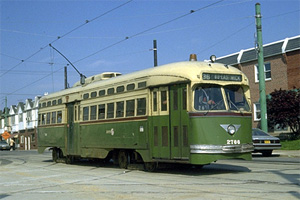
|

(Route 47)

|
After its aquisition
of Philadelphia Transportation Company in 1968, it took less than
a year for SEPTA to kill the first of many electric trolley lines
it had inherited from predecessor PTC.
Beginning in deep South
Philadelphia at Wolf Street, Route 47 occupied 8th and 9th Streets
through South Philly, Center City, and North Philly, and 5th Street
through Olney as far as Godfrey Avenue.
For a more detailed article about Route 47's last days, follow
this link.
1948 PCC 2117 threads
its way through the Itallian Market on South 9th Street in June
1967. Trolleys are long gone but the Italian Market, a Philadelphia
"institution," continues to this day.
Photo by Andrew W. Maginnis
|
 |
|
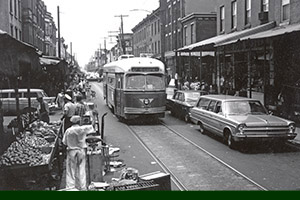
|

Route 50

| Route 50 ran
from the northeast Phila neighborhood of Lawndale, down Rising Sun Avenue
and 4th and 5th Streets to far South Phila. This line saw the use of
the Blackpool England "Boat Car" trolley during the Bicentennial of
the Declaration of Independence in 1976. Trolleys stopped running in
1980, and despite denials by SEPTA management, crews ripped up track
on 5th near Girard Avenue in 1983. The SEPTA board sealed the line's
fate in 1985.
Here's what the Philadelphia Daily News had to say, on October 24,
1985:
SEPTA DERAILS 2 TROLLEY LINES
"In a meeting marked by debate and public criticism, the SEPTA board
yesterday reluctantly voted to close two Philadelphia trolley car
lines so they could be converted to bus operations. 'I abhor this
vote,' said Judith E. Harris, one of Philadelphia's two representatives
on the 11-member board. Harris said board members should be more concerned
with improving public transit than destroying it."
Still the trolley-to-bus conversions continued.
(above right) 1942 PCC 2600, formerly a two-man car, on 5th Street
near Independence Hall. December 17, 1977 photo by Mike Szilagyi
|
 |
|
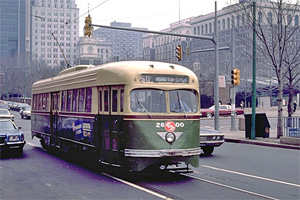
|

Route 53

Route 53 connected
fashionable West Mount Airy on Wayne Avenue, to North Philadelphia,
with the east end of the line looping on the grounds of Luzerne Depot.
In 1938, the first fleet of twenty PCCs were placed in service on this
line. SEPTA abruptly tore down overhead wires on the Route 53 in 1989,
four years after classifying the line "temporary bus".
1942 PCC 2636 crosses Hunting Park Avenue at Simon Gratz High School,
July 8, 1977 photo by Mike Szilagyi |
 |
|
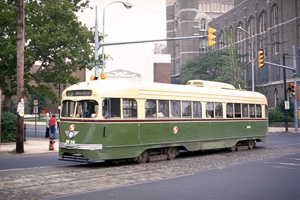
|

Route 56

When this streetcar
entered service in 1948, the PTC scheduled sixty-four trolleys to handle
the thousands of riders who lived and worked along Route 56. By the
end of service in 1992, only about 18 cars were needed for the line,
which runs from Nicetown, along Erie Avenue and Torresdale Avenue to
Tacony. Although SEPTA promised, in 1992, to buy new LRVs for this line,
current managment has no intention of doing so. PennDOT has been allowed
to pave over rails in some places, and SEPTA went to great expense to
cut down steel overhead line poles along Torresdale Avenue.
Freshly overhauled 1948 PCC at 5th Street and Erie Avenue in May
1981. photo by Mike Szilagyi |
 |
|
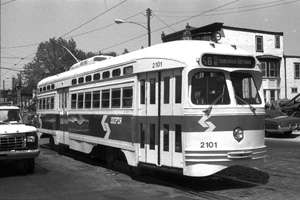
|

Route 60

Route 60
used wide Allegheny Avenue in North Philadelphia, connecting East
Falls with Port Richmond and the Route 15 trolley. Without public
hearings, SEPTA replaced streetcars with diesel buses in 1977. In
1983 a City Water Department crew tore out 700 feet of trolley track
between Amber Street and Frankford Avenue. A Daily News article at
the time quoted an official as saying "We were told the rails were
deteriorated, and trolley cars wouldn't be using Allegheny Avenue
any more."
Ex-Kansas City PCC on Allegheny Avenue at Kensington in July 1971.
Photo taken during a fan trip by M. Harrington |
 |
|
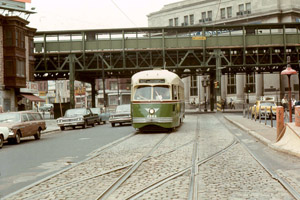
|
(Route 62)

PRT estabished
a new trolley line through Yeadon and Darby Boroughs (in Delaware
County just outside the city limits) in 1918. Only a mile in length,
Route 62 served as a shuttle linking the suburban terminal loops of
two major car lines (Routes 11 and 13). In later years, Route 62 service
was provided by one of two air-electric PCC cars, each of which was
required to carry a certificate proving its owner (PRT and later PTC)
had paid a nominal fee for permission to operate in Yeadon Borough.
Route 62 ceased running as a separate line in 1971, becoming a weekday
rush hour-only extension of the Route 13 trolley.
1942 PCC 2632 splashes through high water on Chester Avenue in
Yeadon Borough.
Photo by Ed Havens |
 |
|
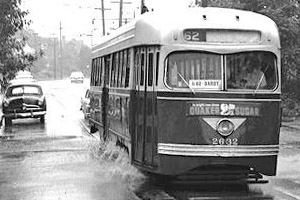
|
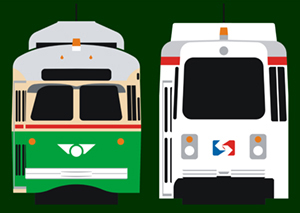
Return to Philadelphia Trolley
Tracks main page.
 By 1958, almost one thousand trolleys and thirty-five
trolley routes had been scrapped, replaced by a fleet of as many new General
Motors diesel buses (National City Lines was organized by General Motors, Firestone
Tire, Standard Oil and Phillips Petroleum). The remaining fleet of about 500
PCC trolleys served the fourteen surviving routes, including the five lines
that utilized the city's new extension to the Subway-Surface tunnel.
By 1958, almost one thousand trolleys and thirty-five
trolley routes had been scrapped, replaced by a fleet of as many new General
Motors diesel buses (National City Lines was organized by General Motors, Firestone
Tire, Standard Oil and Phillips Petroleum). The remaining fleet of about 500
PCC trolleys served the fourteen surviving routes, including the five lines
that utilized the city's new extension to the Subway-Surface tunnel.














